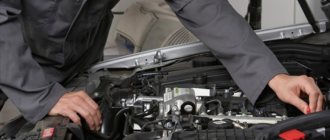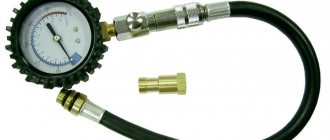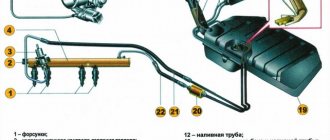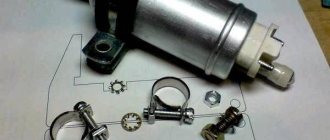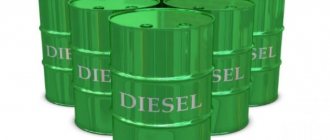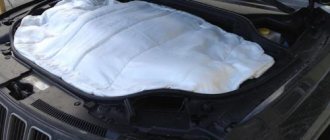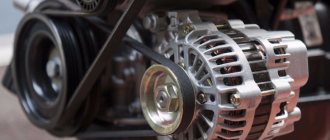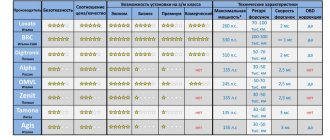The strength of an anchor chain is equal to the strength of its weakest link.
A saying of old English skippers
Gas engine
It is more correct to call it a spark ignition engine. Why? If only because fuel manufacturers in some countries add up to 20–24% ethyl alcohol to gasoline. Thus, the engine can be called gasoline-alcohol.
Until about the middle of the last century, the carburetor dominated the power supply system of such engines, and power mainly depended on the working volume. Currently, carburetors are extinct, and I would conditionally divide contemporaries into several groups:
- naturally aspirated engines with injection into the intake manifold (they are also called naturally aspirated engines)
- direct injection engines
- supercharged engines
- engines with direct injection and turbocharging.
In approximately the same order, the technical characteristics of these engines increase, but at the same time their reliability decreases.
Atmospheric engine Renault
Good old aspirated engine from Renault.
One of the most reliable and trouble-free engines on our market. The heart of many Logans, Sanderos, Largus and Dusters. Good old aspirated engine from Renault. One of the most reliable and trouble-free engines on our market. The heart of many Logans, Sanderos, Largus and Dusters.
Naturally aspirated engines with distributed fuel injection into the intake manifold are simple in design. They have a reliable control system. Modifications with phase control at the intake and exhaust provide good performance in terms of liter power (this is the ratio of engine power to its working volume in liters). Modern engines with a displacement of 1.6 liters produce power of about 125–130 hp. Specific performance (the same power extracted from a unit of displacement) can only be improved by increasing the crankshaft speed to 7–8 thousand rpm, but this requires the creation of a completely different, “near-sports” engine, as well as an improved transmission. For example, back in the early 1990s, Honda developed a 1.6 liter engine that produced 160 hp. But with modern environmental standards, it’s better not to even think about it.
GDI - Gasoline Direct Injection
GDI - Gasoline Direct Injection - injection of gasoline directly into the combustion chamber.
One of the pioneers in introducing the system was Mitsubishi, but Kia (their engine in the photo) creatively developed the research. GDI - Gasoline Direct Injection - injection of gasoline directly into the combustion chamber. One of the pioneers in introducing the system was Mitsubishi, but Kia (their engine in the photo) creatively developed the research.
Direct injection slightly improves engine performance and environmental friendliness. But it is significantly more complicated, since it requires the use of a high-pressure fuel pump (HPF) and special injectors. Moreover, the spread of such engines is hampered by the need for high quality fuel. It is not without reason that many companies did not supply such engines to our country for a long time. In our country, you already drive up to a gas station as if you were approaching a roulette table, and here the engine is more demanding.
engine with Lexus electronically controlled turbocharging system
This engine with an electronically controlled turbocharging system is installed in Lexus cars.
This engine with an electronically controlled turbocharging system is installed in Lexus cars.
Supercharging allows you to significantly increase performance or reduce displacement while maintaining the same power. The one and a half liter engine develops from 150 hp. and more. The maximum torque of the supercharger, in contrast to the torque of the aspirated engine, is achieved much earlier, already at a crankshaft speed of 1600–1800 rpm, and the “shelf” of high torque can extend up to 4000–4500 rpm. This is all thanks to the optimal air supply to the piston part of the engine via an electronically controlled turbocharger. As a result, the supercharged engine at light and medium loads is slightly more economical compared to its naturally aspirated counterpart, all other things being equal. Such an engine pulls well from the very bottom, and at low speeds there is less energy loss due to friction due to the shorter paths traversed by all engine parts and, accordingly, higher efficiency.
High Pressure Fuel Pump Systems
High pressure fuel pump systems: 1 - boost pressure corrector;
2 - engine stop solenoid valve; 3 — coolant temperature corrector. High pressure fuel pump systems: 1 - boost pressure corrector; 2 - engine stop solenoid valve; 3 — coolant temperature corrector.
It had a centrifugal fuel injection advance regulator, a device for ensuring starting fuel supply, a supply corrector depending on the boost pressure and a thermal corrector that increases the amount of fuel when the engine is cold. A fuel priming pump was built inside. And only one wire connected to the entire engine power system - to the solenoid valve. It was possible to drive a car with such a diesel engine without a battery and a generator! As soon as the shut-off element of the solenoid valve was removed, the diesel engine became completely beyond the control of the old men Volt and Ampere. It was possible to start the car using a pushrod and stop it with a transmission. Now that's reliability! Therefore, then I voted for such a diesel engine with both hands.
A modern diesel engine is similar in complexity and capriciousness to a supercharged gasoline engine. The main reason is the Common Rail power system, which pumps up enormous pressures, while ensuring high performance and an equally high price. Add to this urea and particulate filters, due to which the electronics periodically release whole clouds of soot onto their downstream neighbors. All this makes diesel less attractive from a consumer point of view.
Let's sum it up
So, we found out whether it is possible to install gas on a diesel engine. Due to a different operating principle, installing an LPG on such a motor requires major modifications. Moreover, as a result, this unit will still require, albeit a small, portion of diesel. There are savings from using such equipment. But it is so insignificant that no one bothers with the question “is it worth installing gas on a diesel engine?” High payback periods and installation complexity are the main factors that prevent the use of gas-cylinder equipment on a diesel engine.
The switch from gasoline to gas will not surprise anyone for a long time. This is at least profitable, which is why cars with LPG are in high demand on the secondary market. Even when buying a new car, we are interested in the possibility of installing a gas cylinder. In this case, as a rule, we choose one with a gasoline unit, not knowing about the possibility of installing LPG on a diesel engine.
diesel engine
Oh, the modern diesel is not easy!..
Oh, the modern diesel is not easy!..
To summarize, we can say that modern diesel engines provide excellent performance in terms of power, torque, and efficiency. But some manufacturers have not resolved the issue of noise and vibration that arise due to much higher pressure in the cylinders during fuel combustion. In addition, there is always a danger of refueling out of season, and this can lead to problems with starting the engine in cold weather. And diesel engines do not shine with reliability due to their design complexity.
Gasification
I would like to point out right away that additional installation of gas equipment with an acceptable cost of effort and money is only possible on engines with spark ignition. Modern diesel can only be converted to gas at the factory. As for converting an ordinary gasoline car to gas, the tightening of laws requiring certification of such modifications does not add optimism. The time and money spent will not be repaid by safe operation. After all, with very long mileages, and only with such high mileage do you turn on the gas, you can “rock” the car faster than it gets to the next check. Although if you go through all the procedures, you can drive, saving on refueling. True, part of the luggage compartment will be occupied by a gas cylinder, acceleration dynamics will decrease slightly, and the consumption of even cheap gas will be quite high. Of course, on average, the twice lower price of gas compensates for this overexpenditure.
Economic effect
The most important thing here is monetary interest. The higher the oil price, the better gas fuel systems will develop. Developers are constantly developing systems, providing more and more diesel engines. The most important thing is the availability of appropriate gas stations.
Advantages of gas
Replacing fuel with gas provides the following advantages:
- Save time and money.
- Since the gas will burn better, all the characteristics and power of the car will increase.
- The engine will run quieter.
Flaws
But there are some disadvantages:
- Installing LPG on a diesel engine is not a cheap pleasure.
- Problem with gas stations. Not all places have the option to purchase methane.
- You will only benefit from diesel fuel gas if you travel long distances in your car. That is, when more than 50 thousand kilometers are covered in a year.
As you can see, all the shortcomings relate only to the price of materials. There is nothing that reduces the technical aspects of the vehicle.
Gas equipment for engine
A gas "spider" climbed into the engine compartment of a gasoline engine.
A gas "spider" climbed into the engine compartment of a gasoline engine.
I myself drove cars with gas equipment for about 15 years, and installed it myself. But these were carburetor cars, where all settings could be made without special equipment. I was not involved in registration and never did pressure testing of cylinders. In those days there were simply no mechanisms for such verification. And now certification is mandatory, without it you won’t be able to fill the car, without it you won’t be given a diagnostic card. No wonder those years were called the dashing nineties... Nevertheless, I went and was happy. And this was in Moscow, although it happened to travel around the country.
Results
I will express my personal opinion. For the first seven years after graduating from university, he was involved in testing and fine-tuning diesel supercharged and naturally aspirated engines. I had in personal use a bunch of domestically produced carburetor cars, many of which (from UAZ-469 to Tavria) I installed gas equipment on. While working in a publishing house, I drove many cars of domestic and foreign production. And I concluded for myself that there is nothing better than a naturally aspirated gasoline engine with fuel injection and a timing chain drive instead of a belt. The most hassle-free option! And it makes sense to install diesel engines on fairly heavy SUVs, pickups, delivery vans, small trucks and further down the list, right up to long-haul tractors.
Petrol, diesel or gas - which engine is better?
LPG for diesel
in relation to the use of propane as an additive to diesel fuel for use in a diesel engine - discussions about octane numbers are out of boredom. you can pour oil from a deep fryer into it, which has no number, or anything else that is liquid and burns, and everything will work
Nimble. This is when you use the standard nozzles to spray this oil from the fryer. Moreover, in a mixture with diesel fuel, the cetane number of which will ensure ignition on time... Gas in a gas diesel engine is supplied to the inlet as in a carburetor gasoline engine. The only difference is that stoichiometry is not needed. Here everything is as always on a diesel engine - the amount of fuel you supply is the same amount of power you get. This gas is ignited from diesel fuel, so there are no problems with the ignition power. Ibadullaev did not need to invent an ignition system, but to eliminate the injection of diesel fuel!
Then it’s a little more complicated. This results in two combustion processes. One takes place in a diesel torch - everything is great and clear here: the combustion of diesel and gas mutually improve each other in all modes. The second is the combustion of gas outside the diesel torch. This combustion occurs almost like in gasoline engines - therefore it is strongly influenced by both stoichiometry and octane number. A lean gas mixture practically does not burn on its own - therefore, there is simply no point in supplying gas at low loads and at idle - most of the gas will simply pass through the piston and fly out into the pipe. Especially on the vortex chamber. At medium loads, the mixture approaches stoichiometry and the gas begins to burn on its own. Burning off the diesel soot as well. But when the load increases and the gas supply increases, when stoichiometry is reached, a purely gasoline problem emerges - detonation. The degree of compression in the vortex chamber is much higher than the octane characteristics of the gas, for which the maximum coolant is 14. In the vortex chamber, the conditions for the development of detonation do not seem to be very favorable, but above 40% of diesel fuel is not guaranteed to be replaced by gas and not in all engine operating modes. We're talking about propane-butane. There is much more on methane, but the trend is the same.
Moreover, gas on a diesel engine is an add-on that reduces the cost of fuel and oil and allows, in some modes, to obtain 20% more engine torque due to a significant shift in the smoke limit. The maximum power does not actually change.
behind the intercooler? in front of the turbine?
I'm not like other people. And for some reason my turbine is located BEFORE the intercooler. I plan to supply the gas in liquid form immediately AFTER the intercooler for additional cooling of the air compressed by the turbine with the evaporating liquid phase of the gas. Those. there will be no evaporator heater - the gas will evaporate in the receiver in front of the valves.
There will probably be a reducer with an output pressure of about one and a half to two atmospheres, there will be either one electronically controlled liquid gas (gasoline?) nozzle (most likely), or two or three electronically controlled gas valves with conventional gas nozzles.
Well, a standard line with a gas cylinder and all the accompanying refueling piping. Those. Everything is quite simple and absolutely cheap. That's the beauty of it. Modified on March 11, 2020 by Zhornic

